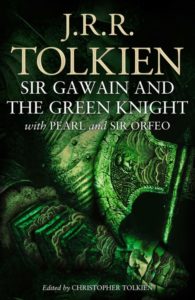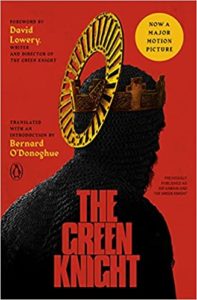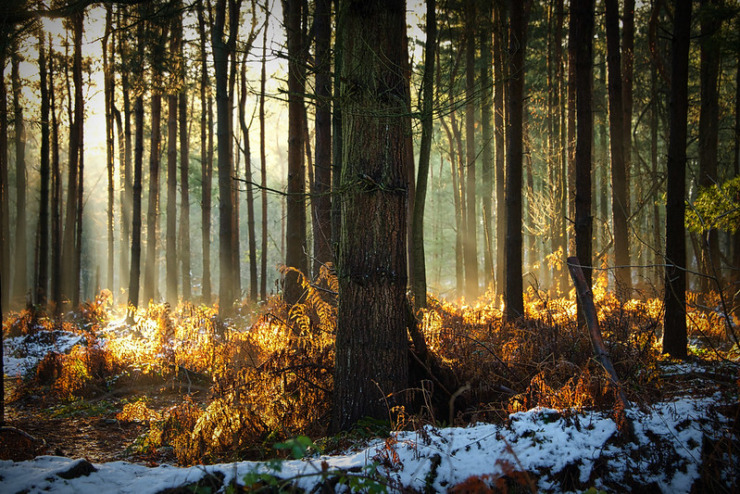The Green Knight has multiple modern translations and a movie
Sir Gawain and the Green Knight — at one time a staple of college reading for English lit majors — has a curious history. The author was roughly contemporary with Geoffrey Chaucer (1340s-1400). The poem ranks as one of the two great poems of the period, along with Chaucer’s Troilus and Crisedye.
The author’s identity, however, remains unknown. He used an English dialect representative of the Midlands area of England (Chaucer’s English was London through and through). Some scholars have suggested that some of its scenes would situate the poem in Staffordshire in west-central England. It exists in a single manuscript, together with Pearl and two bible stories entitled Purity and Patience. The poems are written in the same hand and the same English dialect.
The manuscript was unknown until it surfaced in the library of Henry Savile (1569-1617), who lived in Bank in Yorkshire. The manuscript is now with the British Library in London.

The Green Knight (using the shorthand name) begins with a celebration. It’s New Year’s Day, and King Arthur is hosting a festive banquet for the Knights of the Roundtable and the court. He laments that he’s rather bored and is looking for some new stimulation. No sooner said than done. The doors to the hall fly open, and in comes a huge and entirely green knight. He offers a challenge: someone to step forward and strike him a mortal blow, in return for coming to the Green Chapel a year hence and offering himself to a mortal blow.
No one accepts, until Sir Gawain, the purest and most saintly of the knights, steps forward. He beheads the Green Knight, who promptly picks up his head and tells Gawain he’s expected in a year. He leaves, and soon life settles back to normal.
But as the end of the year soon approaches, Gawain holds to his commitment. And off he goes. The problem is that neither he, nor anyone he asks, knows where the Green Chapel is. He wanders, enduring some grueling trials, until he comes to a castle where the lord tells him he’s close to his quarry. But the lord prevails upon Gawain to stay for a time, and soon a game is put into play involving the lord hunting and Gawain ministering to the lady of the castle. What’s clear to the reader, if not to Gawain, is that the lady is out to seduce him. He resists (mostly), and eventually leaves to find the Green Knight. And what he learns is that the whole event, from the first appearance of the Green Knight, has been a setup by Morgan Le Fay.
The Old English dialect is difficult to read. Here are the first five lines of Section IV in the original manuscript:
Now neghes the New Yere, and the nyght passes,
The day dryves to the derk, as Dryghtyn bides.
Bot wylde wederes of the worlde wakened theroute.
Clowdes kesten kenly the colde to the erthe,
With nyghe innoghe of the northe the naked to tene.
The version I read in Norton’s was a modern English translation in 1967 by Marie Borroff (1923-2019), a well-regarded professor of English at Yale. It’s still a highly readable translation. Here is her translation for the lines noted above:
Now the New Year draws near, and the night passes,
The day dispels the dark, by the Lord’s decree;
But wild weather awoke in the world without:
The clouds in the cold sky cast down their snow
With great gusts from the north, grievous to bear.
For comparison, I read two other translations.

“Now New Year draws near and the night passes, day comes driving the dark, as ordained by God; but wild weathers of this world awake in the land, clouds cast keenly the cold upon earth with bitter breath from the North biting the naked.”
Another, non-Tolkien edition of the poem was published in 2021, this one by writer and director David Lowery to accompany his movie version of the poem, The Green Knight. The movie starred Dev Patel as Sir Gawain, and it was surprisingly popular, given that it was released during the throes of the COVID-19 pandemic and its story comes from a medieval poem (we can probably thank the popularity of The Game of Thrones and the enduring appeal of the King Arthur legend).
This version used a 2007 translation by the Irish poet Bernard O’Donoghue. Of all the versions I read, this one is the most “conversational.” Here are those first five lines from Section IV:
Now the New Year’s approaching, and the night is passing.
The dawn defeats dark, as the Lord ordains it.
But the worst weather in the word brewed up outside;
Clouds drove the cold down to the ground
With enough of north’s sharpness to perish poor people.
These three modern translations are similar, yet they have minor variations. The Borroff and O’Donoghue versions are similar; Tolkien seems to have been aiming more for understanding the broad sweep of the poem, not unlike many of his other writings.
Sir Gawain and the Green Night is a poem about chivalry, faith, honor, intrigue, and deception. It develops its hero, Sir Gawain, from a paragon of chivalric virtue to a more familiar man, one pressing on to fulfill a duty despite his discouragements, frailties, and flaws. He succeeds, but he recognizes where he’s fallen short. And that may be the reason for the poem’s ongoing attraction.
Related:
Simon Armitage Translates Pearl
“Lud’s Church” or “The Green Chapel” – poem by Jeff Eardley at The Society of Classical Poets
Photo by Paolo Camera, Creative Commons, via Flickr. Post by Glynn Young.
How to Read a Poem uses images like the mouse, the hive, the switch (from the Billy Collins poem)—to guide readers into new ways of understanding poems. Anthology included.
“I require all our incoming poetry students—in the MFA I direct—to buy and read this book.”
—Jeanetta Calhoun Mish
- Poets and Fables: Steven Flint and “The Sun and the Boy” - July 3, 2025
- Poets and Poems: Alison Blevins and “Where Will We Live if the House Burns Down?” - July 1, 2025
- Poets and Poems: Paul Pastor and “The Locust Years” - June 26, 2025


Bethany R. says
Thank you for this, Glynn. I remember reading this poem in my fascinating Old English Literature class back in college. Cool to see the way the various translations unfold the same material. That is something I did not explore in that class. Another interesting and educational post–thanks again.
Glynn says
Glad you enjoyed it, Bethany!! I remember my professor — he loved medieval literature and even looked the part — somewhat monkish with a bald spot like a tonsure.